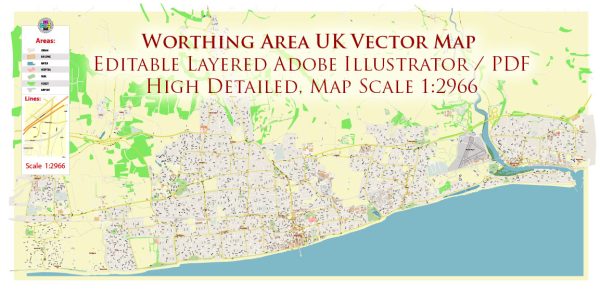Worthing is a seaside town located in West Sussex, England, and its history of urban development is rich and diverse. The town has evolved from a small fishing and farming community into a popular seaside resort with a mix of Victorian and modern architecture.
- Early History: The area around Worthing has evidence of human habitation dating back to the Bronze Age. However, Worthing itself began to develop as a settlement in the late Saxon period. The Domesday Book of 1086 mentions a manor in the area, indicating some level of organized settlement.
- Medieval Period: During the medieval period, Worthing remained a small and relatively insignificant village. Fishing and agriculture were the main economic activities.
- Rise as a Health Resort: In the late 18th century, Worthing gained popularity as a health resort due to the perceived health benefits of seawater and sea air. The town’s growth accelerated during the Victorian era when it became fashionable for the wealthy to visit coastal resorts. The arrival of the railway in 1845 further facilitated tourism and led to increased urbanization.
- Victorian Architecture: Many of Worthing’s prominent buildings and structures date from the Victorian era. Elegant Victorian townhouses, hotels, and public buildings were constructed to accommodate the growing number of visitors. The town’s pier, opened in 1862, became a focal point for entertainment and leisure activities.
- 20th Century: Worthing continued to grow throughout the 20th century. The interwar period saw further urban development, and the town became a popular residential area. During World War II, Worthing, like many coastal towns, faced the threat of bombings, and some areas suffered damage.
- Post-War Development: After the war, Worthing experienced suburban expansion as demand for housing increased. New residential areas were developed, and the town’s infrastructure was modernized. The 1950s and 1960s saw the construction of some modernist buildings, reflecting the architectural trends of the time.
- Contemporary Worthing: In recent decades, Worthing has undergone regeneration projects to enhance its appeal as a seaside destination and a place to live. The town has retained much of its Victorian charm, and efforts have been made to preserve historic buildings.
- Economic Transition: While tourism remains an important part of Worthing’s economy, the town has diversified its economic base. The service sector, retail, and other industries play a significant role in the local economy.
- Cultural and Recreational Amenities: Worthing offers a range of cultural and recreational amenities, including theaters, parks, and cultural events. The town continues to balance its historical heritage with the demands of a modern urban environment.
In summary, Worthing’s history of urban development reflects its evolution from a small coastal village to a thriving seaside town with a mix of historical and contemporary elements. The Victorian legacy is particularly visible in the town’s architecture, contributing to its distinctive character.


 Author: Kirill Shrayber, Ph.D.
Author: Kirill Shrayber, Ph.D.